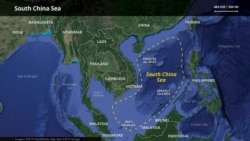Chinese scholars have had scores of reports published in internationally recognized scientific journals containing a mention of their country’s ‘nine-dash line,’ the core of its claim to the hotly contested South China Sea, an American research institution said this month.
China is using the journal pieces to promote its claimed demarcation line, Vietnamese scholar Nguyen Thuy Anh wrote in a July 15 article for the Asia Maritime Transparency Initiative under the Center for Strategic and International Studies.
Journal articles are just China’s latest effort to publicize its nine-dash line for a wide global audience in hopes that the constant reminders will legitimize its claim over the claims of other countries, analysts say.
Maps, globes, postcards, T-shirts, video games and at least one blockbuster film influenced by China refer to the line as well. China has churned out those items for at least 10 years.
“If you do slap a nine-dash line on say DreamWorks movies that get localized and distributed around the world, it does I think send a subtle message that (the) default world view should be that the nine-dash line is real and legitimate,” initiative director Gregory Poling said.
Nguyen, a research fellow at the East Sea Institute of the Diplomatic Academy of Vietnam, found 260 articles using the nine-dash line in 20 “prominent” scientific journals owned by various publishers, her report says.
China vies for maritime sovereignty in the South China Sea with Brunei, Malaysia, the Philippines, Taiwan and Vietnam. At stake is a shared 3.5 million-square-kilometer sea valued for fisheries, energy reserves and commercial shipping lanes.
Beijing claims about 90% of the waterway and has angered weaker neighbors over the past decade by landfilling tiny islets in the sea for military, economic and scientific use.
China refers to the nine-dash line to back its sovereignty claim. The line, literally composed of nine thick dashes, swings south from the Chinese mainland, across waters east of Vietnam, near the north coast of Borneo, and back along the Philippine island of Palawan toward Taiwan. The thickness of lines plus the spaces between them make China’s actual claims vague, analysts have said.
Propaganda and constant reminder
Chinese officials as well as private firms show the nine-dash line in passports, books, online games and tourist brochures, Nguyen said in her report.
In cinema, the most internationally memorable example was a scene from “Abominable,” an animated movie made by China-based Pearl Studio and America’s DreamWorks Animation. The film was banned in Malaysia, the Philippines, and Vietnam last year because of the scene.
Vietnamese officials in 2018 denounced the arrival of 14 Chinese tourists who flew into the Southeast Asian country wearing T-shirts showing the disputed line. Five years earlier Philippine booksellers quit selling made-in-China globes showing the Chinese demarcation line.
The government in China, a major exporter of globes, last year published a notice aimed at ensuring that any map-bearing materials make the Chinese “position on territory clear to the international community,” state-controlled media outlet Global Times online said.
'Target audience'
China is aiming these materials at a “target audience” of Arab, African, and other “third countries” rather than Western consumers, Poling said. A student doing research in Africa, he said, would see probably the nine-dash line on a globe and not question it.
Few world consumers know what the line means, said Jay Batongbacal, international maritime affairs professor at University of the Philippines.
“Most of them don’t notice it, because they’re not really familiar with South China Sea issues, meaning this goes over their heads,” Batongbacal said. “That’s why China is doing this. It’s like a subtle propaganda effort, which they will use later on to say the nine-dash line is well known to everybody because it’s in all these products and articles and whatnot.”
China cites historical records to support its maritime claim. In 2016 a world arbitration court ruled against the claim’s legal basis in the South China Sea. Southeast Asian countries that assert their maritime sovereignty, sometimes sparring with Chinese vessels in the contested sea, normally rely on 370-kilometer-wide exclusive economic zones extending from their coasts.
People offshore and on are supposed to pay attention to the nine-dash line merchandising, said Huang Kwei-bo, vice dean of the international affairs college at National Chengchi University in Taipei. The Chinese government regularly reminds citizens of its achievements overseas to drum up support for the state and ruling Communist Party.
“Its actions of this type actually have two points – one is to approach the international community and promote that the PRC has had the whole South China Sea forever, but another point of course is for what amounts to domestic patriotic education,” Huang said.










